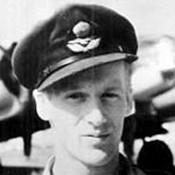A body recently recovered from a Second World War aircraft crash site in
southern Germany has been formally identified as that of one of the Royal Air Force's most distinguished wartime
reconnaissance pilots, Wing Commander Adrian
Warburton, DSO *, DFC **.
A full military funeral will be held next year.
His remains were found in the wreckage of a USAAF F-5B Lighting reconnaissance
aircraft. Wg Cdr Warburton failed to return from a mission on 12 April 1944; at
the time, he was serving as the RAF Liaison Officer with the US 7th Photographic
Reconnaissance Group, based at Mount Farm, Oxfordshire, one of whose aircraft he
was flying.
Adrian Warburton joined the RAF as a pilot in 1938, and initially served with a
torpedo-bomber unit, 22 Squadron. In 1940, the squadron was tasked with
assessing the Martin 167F Maryland - a fast US light reconnaissance-bomber which
had been built for the French armed forces. With the fall of France in 1940,
the RAF took over the contract. Three aircraft were delivered to 22 Squadron,
and having passed their tests, Flight Lieutenant Whiteley led the aircraft south
across occupied France in September to form 431 Flight on Malta.
Pilot Officer
Warburton was one of the aircrew who flew with him, albeit serving as a
navigator rather than a pilot. However, on arrival in Malta, two of the pilots
fell ill, and Whiteley decided to train Warburton to fly the Maryland. This
nearly ended in disaster - Warburton twice came close to crashing the
high-performance aircraft - but perseverance paid off, and he went on to become
the most successful pilot on the type.
One of the most important tasks for the new reconnaissance flight - which
boasted a small and motley collection of other aircraft, including a Skua and a
couple of Blenheims - was to monitor the powerful Italian fleet in Taranto, a
task requiring long and arduous patrols of up to seven hours. The Maryland
boasted some fighter characteristics, and proved capable of looking after itself
in air combat.
On 30 October 1940, Warburton and his two crewmen shot down an
Italian Z.506B seaplane. Three days later, however, they nearly fell victim in
turn to an attack by four Italian aircraft. Warburton was hit by a spent bullet
which caused no serious injury but did render him unconscious. Sergeant Frank
Bastard took control and managed to keep the aircraft flying until Warburton had
recovered sufficiently. Bastard received the Distinguished Flying Medal.
Warburton was soon back in the air, and the crew again had to fight off multiple
attacks over Taranto on 7 November.
On 10 November, 431 Flight spotted a major
concentration of Italian battleships and cruisers in Taranto, and Admiral
Cunningham decided on an audacious night attack by Fleet Air Arm Swordfish from
HMS
Illustrious. Warburton was tasked with conducting the last
reconnaissance mission on 11 November, immediately prior to the attack being
launched. On this occasion, the cameras failed to work. But he and his crew
were able to provide very detailed visual reports on the precise disposition of
the ships in the harbour. Guided by this intelligence, the Fleet Air Arm
launched its devastating attack that night. Flt Lt Whiteley's photographs the
next morning confirmed the crippling damage inflicted on the capital ships.
Warburton steadily developed a reputation as the leading recce pilot on Malta.
He and his crew were frequently involved in air combats, claiming five
air-to-air victories, and three enemy aircraft destroyed on the ground or afloat
on the water.
In April 1941, he crash-landed in Malta after being mistakenly
intercepted by an RAF Hurricane. Warburton was rested later that year, but
returned to operational flying in 1942, with further missions over Italy and
North Africa. He crashed twice, but each time walked away to safety. He was
involved in the vital pre-invasion reconnaissance of the landing beaches in
Sicily, but finally returned to the UK after suffering serious injuries in a
road traffic accident. Having recovered, he was posted as a liaison officer to
the 7th US Photo-Reconnaissance Group, but was lost on operations shortly
afterwards. His career had earnt him the Distinguished Service Order and Bar,
and the Distinguished Flying Cross and Two Bars.
Wing Commander Warburton's family have been traced, and informed of the recovery
of his remains. It is planned that he will be buried with full military honours
in a Commonwealth War Graves Commission cemetery near Munich in 2003.

FROM SKY NEWS
MAY 14th 2003The most decorated airman of the Second World War has finally been given a military send-off - almost six decades after he went missing in action.
Wing Commander Adrian Warburton was laid to rest in a Commonwealth war grave in a small corner of southern Germany.
The grave is just miles from where he was shot down 59 years ago.
His demise and whereabouts remained a mystery after he failed to return from a reconnaissance mission over Nazi Germany in April 1944.
But last year his crash site and remains were finally unearthed thanks to years of hard work by aviation researchers.
Warby, as he was affectionately known, was given a long-overdue official funeral with full military honours.
Prior to the burial at Durnbach Commonwealth War Graves Cemetery, a funeral service was held for the 26-year-old flying ace.
Among the hundred or so mourners was Warby's widow, Betty Westcott, 91, who spent just a few weeks married to him before he moved to Malta in 1940.
She never heard from him again but wanted to be present to pay her respects. "I wanted to be here today because I felt I should be and it was proper," she said.